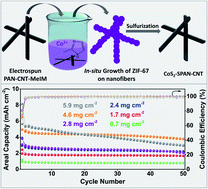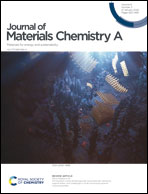Anchoring MOF-derived CoS2 on sulfurized polyacrylonitrile nanofibers for high areal capacity lithium–sulfur batteries†
Abstract
Sulfurized polyacrylonitrile (SPAN) is attractive as one of the most promising cathode candidates for commercial lithium–sulfur (Li–S) batteries due to its outstanding capacity reversibility and structural stability. However, the limited sulfur content of ∼40 wt% in the composite hinders its practical applications owing to insufficient areal/volumetric energy density, especially when used as flexible cathodes for wearable energy storage devices. Here, we report an ultrathin and condensed SPAN film synthesized via the in situ growth of ZIF-67 on electrospun fibers composed of PAN and CNTs, followed by a vulcanization process to generate surface-anchored CoS2 that effectively suppresses fiber swelling and film thickening. Simultaneously, conductive CoS2 helps expedite the redox kinetics of sulfur conversion for achieving high-performance Li–S cells with much improved areal capacity. This study refreshes current performance of SPAN cells with an ultrahigh initial areal capacity of 8.1 mA h cm−2 at a sulfur loading of up to 5.9 mg cm−2, as well as a superior capacity of 1322 mA h g−1 in the prototype pouch cell, demonstrating great prospects of the employed protocol for realizing flexible Li–S batteries with high energy density.



 Please wait while we load your content...
Please wait while we load your content...